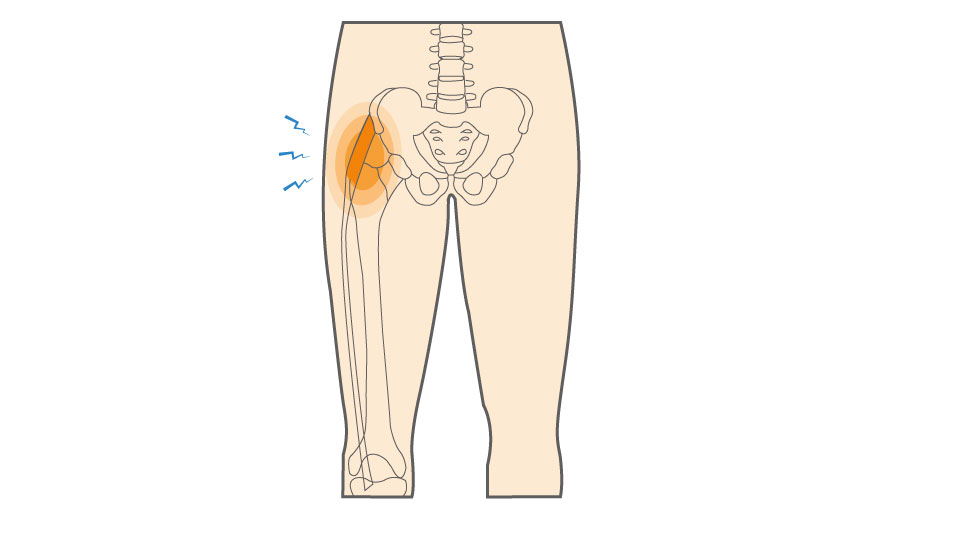Iliotibial band (IT) tendonitis, also called iliotibial band (IT) syndrome, is a condition characterized by inflammation that affects the iliotibial (IT) band of the upper leg. The IT band runs along the outer part of the thigh, from the hip to the knee. It consists of connective tissue called fascia, which connects the buttock and hip muscles to the top of the shin bone. IT band tendonitis is most common in runners.
Iliotibial (IT) Band Tendonitis of the Hip Treatment
Iliotibial band (IT) tendonitis, also called iliotibial band (IT) syndrome, is a condition characterized by inflammation that affects the iliotibial (IT) band of the upper leg. The IT band runs along the outer part of the thigh, from the hip to the knee. It consists of connective tissue called fascia, which connects the buttock and hip muscles to the top of the shin bone. In fact, the IT band is the largest fascia in the body and helps to stabilize the knee while running. This condition is also commonly referred to as hip IT band syndrome and is a frequent running injury.
Overview
Overview

What causes Iliotibial (IT) Band Tendonitis of the Hip?
IT band tendonitis is a non-traumatic injury that is brought on by overuse. It usually occurs in runners when the band is tight or has been overworked. Common causes of IT band tendonitis include:
- Overtraining
- Running only one course
- Wearing footwear that is worn out
- Improper foot mechanics
- Failing to stretch sufficiently
This type of running injury can lead to long-term outer hip pain if left untreated.
Iliotibial (IT) band tendonitis is common in these sports:
- Long-distance running or marathon running
- Soccer
- Tennis
Symptoms
You may have IT band tendonitis if you experience one or more of the following symptoms:
- Pain on the outside of the hip along the IT band
- Pain with sleeping on the hip
- Pain that increases when climbing or descending stairs
These are hallmark signs of hip IT band syndrome.
When to see a doctor
If you notice pain outside the hip that does not resolve independently, make an appointment with an orthopedic specialist, as this may indicate inflammation of the IT band. During your appointment, your doctor will check for tenderness by touching the outside of your hip. They will also assess the flexibility of the leg by having you perform various stretches, like the Ober’s test.
In order to make a diagnosis, your doctor may prescribe the following imaging tests to rule out other causes of hip pain:
- X-ray
- MRI
Non-operative treatment
IT band tendonitis is treated using conservative, non-operative methods. Treatment for IT band tendonitis may include:
- Rest
- IT band stretches (this is a key factor in IT band tendonitis treatment)
- Non-steroidal anti-inflammatory medication, like ibuprofen, to reduce inflammation
As improper foot and training mechanics may contribute to IT band tendonitis, your doctor may recommend the following treatments to reduce the risk of developing IT band tendonitis in the future:
- Correcting training errors
- Finding proper footwear to encourage proper foot mechanics
These steps are crucial for managing hip IT band syndrome and avoiding future running injuries.
Try these exercises to help address your condition:
Below is a PDF of the Exercise Program
Surgical Treatment
IT band tendonitis does not require surgery and is almost always treated conservatively, using non-operative treatments.
Most cases of lateral thigh friction or outer hip pain from IT band issues resolve without surgical intervention.
Recovery
You can return to training when you have no pain and have regained flexibility in the leg. When you are recovering from IT band tendonitis, it is important that you return to running gradually. You will also need to make sure that you warm up carefully and stretch both before and after exercising.
Recovery from hip IT band syndrome requires patience, consistent stretching, and proper post-run care.
GET BACK TO WHAT YOU LOVE. FASTER
Sources
https://news.harvard.edu/gazette/story/2015/08/understanding-the-it-band/
https://www.webmd.com/pain-management/it-band-syndrome#1
https://www.emedicinehealth.com/iliotibial_band_syndrome/article_em.htm
https://www.runnersworld.com/it-band-syndrome
https://www.physio-pedia.com/Iliotibial_Band_Syndrome
https://www.medicinenet.com/iliotibial_band_syndrome/article.htm
Frequently Asked Questions
Can IT band tendonitis go away on its own?
Mild cases may improve with rest and simple at-home care, such as icing and stretching. However, if symptoms persist or worsen, medical evaluation is necessary. Ignoring the pain can lead to chronic issues or compensatory injuries in other areas.
How can I prevent IT band tendonitis from coming back?
Prevention involves a combination of proper stretching, strengthening exercises (especially for the hips and glutes), wearing appropriate footwear, and avoiding training errors such as overuse or poor form. Incorporating a warm-up and cool-down into your workout routine is also key.
Is it okay to continue exercising with IT band tendonitis?
It’s best to avoid high-impact activities, especially running, while symptoms are present. Instead, opt for low-impact exercises like swimming or cycling at a low resistance. Always consult your doctor or physical therapist before resuming your training routine.
How long does it usually take to recover from a running injury like IT band syndrome?
Recovery can take anywhere from 2 to 8 weeks with non-operative treatments, depending on the severity and adherence to stretching and strengthening routines.

